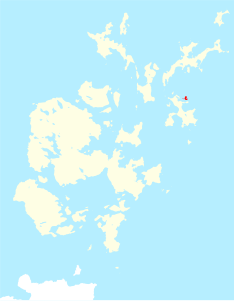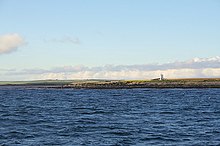Papa Stronsay
| Papa Stronsay | |
|---|---|
| Aerial view of Papa Stronsay | |
| Waters | North Sea |
| Archipelago | Orkney |
| Geographical location | 59 ° 9 ′ 0 ″ N , 2 ° 35 ′ 0 ″ W |
| surface | 74 ha |
| Residents | uninhabited |
Papa Stronsay (Old Norse Papey Minni) is a 74 hectare, up to 13 m high island in Orkney , north of Scotland . "Priest Island of Stronsay" is the old Norse name of the side island of Stronsay , which is northeast of the main island. One of the northernmost early Christian monasteries of the Orkney and a Celtic cross were found here. The monastery, founded in the 7th or 8th century, has historical significance for the archipelago .
While ten people were still living on Papa Stronsay in 2001, the island was uninhabited at the time of the 2011 census.
history
The modern Golgotha Monastery on Papa Stronsay was built in 1999 by the Order of Transalpine Redemptorists after the renovation of the manor house and the largely dilapidated fishing station on the island.
The murder of the last offspring of Sinclair (originally St Clair) Earls Rognvald Brusason by Earl Thorfinn Sigurdsson (the Mighty) and Thorkel Fostri (the Fosterer) took place on Papa Stronsay in 1046 AD (compare Orkneyinga saga, Chapter 29), his henchman, near St Nicholas Chapel , which was excavated from 1998. Thorfinn was a son of the Viking King Sigurd II Digri Hlodversson, of Dublin , who was killed in the Battle of Clontarf . According to local tradition, Rognvald Brusason is said to have been buried in Earl's Knoll, a long cairn about 75 m long and up to 20 m wide, on Papa Stronsay (no archaeological evidence to date).
Since the 16th century it was the base of the Scottish, later British, herring fleet , whose activities ended before the Second World War . There is an eight meter high beacon in the northeast. There is no gas, electricity or water supply on Papa Stronsay. Electricity is generated with a diesel generator. Water comes from wells that have been drilled into the rock.
Seaweed (kelp)
A rare form of an "improved" kelp kiln, a relic from an unsuccessful attempt at the turn of the 20th century, survived on the island. There are two approximately 2.0 and 1.4 m high "chimneys" made of dry masonry which are approximately 5.0 m apart, the latter stands in a stone platform with a chimney opening. The “chimneys” are connected by tunnels. It is unclear how this arrangement worked.


